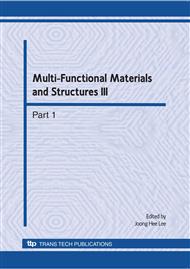p.907
p.911
p.915
p.919
p.923
p.927
p.931
p.935
p.939
Photosensitization of Dye/TiO2 Thin Films by Using Natural Dye of TCPP
Abstract:
The Dye-Sensitized TiO2 thin film fabricated by TiO2 nanoparticles is a novel technology with advantage in low cost, little pollution and simple in manufacturing process. The fiber-shaped reacting sites provide enlarged photo-sensing area of the TiO2 thin films. Natural dye of TCPP was applied to improve the photo absorbability in this study. Besides, a novel plasma surface activation technique employed on the thin film showed well performance compared with previous reports by heating methods. The SEM images demonstrate that the nano-TiO2 composites deposited on the fiber substrate. Degradation of acetone under 365 and 420 nm light irradiation were conducted to evaluate the photocatalytic ability of the TiO2 and TCPP/TiO2 thin films. While TiO2 thin films gel catalyst showed good photocatalytic performance with a high degradation efficiency of 99.9%, only about 80% conversion efficiency was achieved by the TCPP/TiO2 thin films reactor under 365 nm light irradiation. Although the TCPP dye on TiO2 nanoparticle shows beneficial reflection intensity in 420 nm, the acetone degradation capability of TiO2 and TCPP/ TiO2 thin films reactor decreased about 30% and 25% respectively compared with the degradation efficiency under 365 nm.
Info:
Periodical:
Pages:
923-926
Citation:
Online since:
August 2010
Authors:
Price:
Сopyright:
© 2010 Trans Tech Publications Ltd. All Rights Reserved
Share:
Citation:


